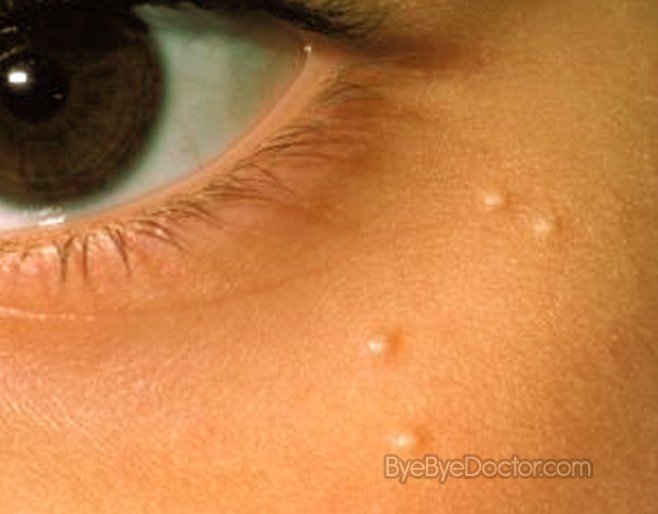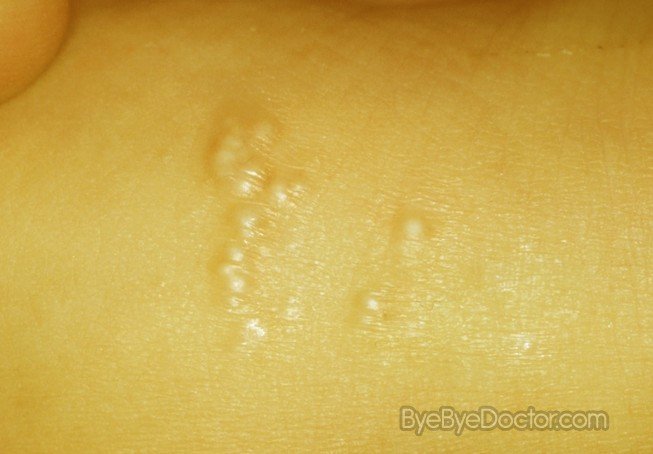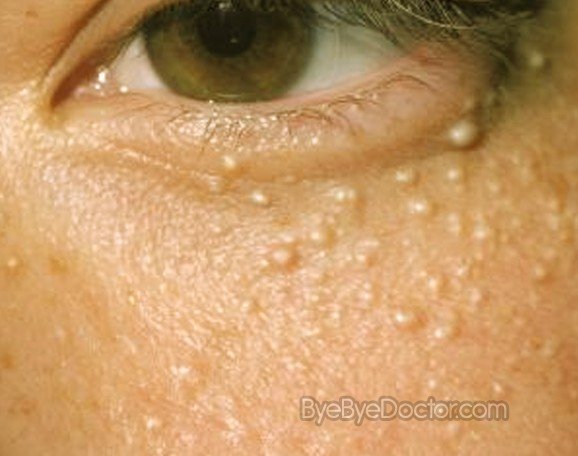Milia
Last reviewed by Dr.Mary on August 7th, 2018.
Milia are white and tiny bumps or small cysts of the skin. There are countless numbers of applications and procedures for exfoliating – creams which are marketed to remove as well as prevent flaws of skin. But dead cells do discover a way round the smooth skin methods, spiraling the face to a vast sea of pinpoint bumps. Actually, the very diligent plan of skin care is usually the fault – it actually traumatizes the skin and leaves instead a case of milia.
They are whitish skin bumps which usually seem on babies especially after birth, however adults get them also. These minute, pimple-appearing cysts develop since the skin dead cells are confined in the surface of the mouth or skin. The primary type of milia normally disappears on their own for both adults and infants. Adults, nevertheless, can also experience milia’s secondary form, that requires some attention medically.
These cysts are caused by the dead cells of skin and may grow after blistering skin rashes, or they may arise from long-lasting skin conditions that already exist. But simple items like exfoliating emulsions, coarse treatment of the skin as well as exposure to the sun may cause enough irritation to generate cases of milia.
In babies, because there is usually slight skin distress at birth, these bumps normally completely develop on the face. Milia on adults may appear anywhere there are ducts for sweat. These areas can be blocked due to extreme skin irritation or pore-clogging formalities.
Milia Symptoms
Milia are more common to be seen on a baby’s chin, cheeks, or nose, although they can develop also in other areas, for instance the limbs and upper trunk. Often bumps that are similar appear on a baby’s mouth roof or the baby’s gums. As mentions before, these are referred to as Epstein pearls. Many babies can also develop what looks like acne, characterized by red small bumps and pustules on the chin, cheeks as well as the forehead.
If an individual becomes worried about the baby’s complexion or it does not clear up inside of 3 months, the baby’s doctor should be consulted.
Here is a list of common signs or symptoms below:
- White bumps on the chin, nose, as well as cheeks of infants
- White bumps on the mouth, eye or gums
- May appear on injured or inflamed parts as white spots
- Irritation may create reddening around the spots but the point remains white
Milia can appear as white or yellow bumps which seem to be just underneath the skin surface, but actually they are deep seeded. The bump can range from 1 to 2 mm in size as well as may be mistaken for acne. They may be found in several bumps clustered together or only one alone.
Milia Causes
For primary milia incidents, like the tiny cyst which develop on a newborn, the skin just cannot remove skin cells which are dead. This means that instead of sloughing off, these cells are trapped and clog the pores which produce oil. This is the type of milia that is fairly common in babies although adults may develop them also.
Secondary milia happen when a condition of the skin causes blistering actually and does damage to the ducts of the skin. This can also result in dead cells of skin becoming confined as soon as they attempt to collect up to the surface and as soon as sufficient dead cells are available, the minuscule dome bumps seen in primary milia stage a surprising visit. Rashes or burns such as poison ivy may cause an amount of blistering that can increase trapped cells of skin on the surface. But disease of the skin such as bullous pemphigold, that causes blistering chronically, can also cause secondary milia
In certain adults, damage from the sun is also a main provider of milia, since it thickens as well as toughens the outer layers of the skin, making it harder for dead cells of the skin to find their way out of the glands. These cysts can then form in the areas which were overexposed to demanding rays. Some other reasons of milia can also be topical steroid use as well as treatments in a spa for example methods of skin resurfacing or dermabrasion.
The same way that skin procedures can cause trauma as well as affect exfoliation of the skin, anything that is put on your face or in your hair can also add oil to the skin and affect the pores. For instances, creamy, heavy skin care merchandises that are comedogenic, or clog pores, can as well add to the occurrence of milia.
If an individual is interested in tackling a milia epidemic at home you can read on to learn some steps that can be taken.
Milia Treatment
If an individual is bothered with milia, there are several things which can be done at home which can make them disappear sooner. A physician can very quickly decide on the severity of the milia simply by looking at the cysts. And the good news is that milia is the very least serious form needing no attention at all.
The type that babies get – primary milia – does not need a physician’s visit unless this condition last longer than a few months. The bumps normally go away within a few weeks. If the physician says that no medical treatment is needed, there are still a few things which you may do to lessen the symptoms.
To start with, stop using your normal lotions or makeup removers. This usually minimizes the spread of the bumps while waiting for these conditions to pass. Oily products are especially problematic. Anything non-comedogenic is probably best, but if possible, it is probably better to avoid using all products or exfoliating processes on areas where you see milia developing.
It does not matter the severity or location, milia affects people of every background and ethnicity and may also appear at any age. It can look like a really bad case of acne, that can be really annoying but the cysts are treatable and also preventable.
Milia Removal
Milia look topical and very trivial but – particularly with the second type – medical experts say that the difficulty can be much deeper. If you do not see a skin physician to define whether you have secondary or primary milia, you can do substantial harm to the skin if you attempt to eradicate them at home. By not using the correct tools – for example those in use in the doctor’s office –this milia is hard to eliminate and often leads to scarring.
If the physician diagnosis a case of secondary milia, you could get a prescription for a retinoid cream. He also might remove the bumps with a scalpel followed by a very special tool named a comedone extractor. As well, the doctor may recommend fruit acid peels as well as other procedures such as microdermabrasion.





Dear Doctor,
I have a two year girl with milia on her cheeks since she was four months old. I saw a dermatologist and she told me not to worry but are not nice to see although they are very small. In winter it seems that she is having more. I am using some lipobase once daily but she is not improving. The doctor also gave me some cream which can be used for eczema but i am afraid to use it. Can you kindly advice me what can I do to help in reducing my girl’s milia.
Thanks